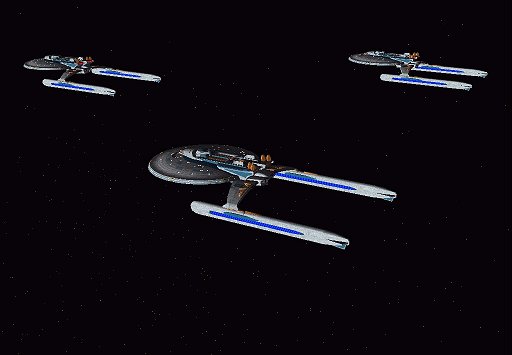
 U.S.S. Wells is one of the Apollo class starships. U.S.S. Wells was launched in 2304 and spent a year undergoing shakedown before commissioning into the fleet. As with other members of the Apollo class, U.S.S. Wells has six decks and a compliment of 115 officers and crew.
U.S.S. Wells is one of the Apollo class starships. U.S.S. Wells was launched in 2304 and spent a year undergoing shakedown before commissioning into the fleet. As with other members of the Apollo class, U.S.S. Wells has six decks and a compliment of 115 officers and crew.
The quote on the dedication plaque of U.S.S. Wells is 'Those who have never seen a living Martian can scarcely imagine the strange horror of their appearance...', from the famous quote in The War of The Worlds (1898) by author H.G. Wells.
As of September 5th 2304, stardate 11537.5, Captain Nathaniel Griffith took command from Captain Kemp. The Wells was assigned to the Beta Quadrant to replace the starship Lexington from frontline duties. U.S.S. Wells is under the auspices of Starbase 77 and as of stardate 11401.5 is currently exploring the planet Q'mar III, before she is due to ferry scientists to Vaarati V. Once there, the Wells will relieve the U.S.S. Valkyrie and U.S.S. Excalibur, allowing them some time at Starbase 77 for crew shore leave and transfers.
The Wells is assigned to escort transports with mobile orbital science facilities to act as a command and control focal laboratoy facility for the planet. Both the Dhama Initiative and Bold Futura have sponsored this science base with their own scientists due to man it. Private Oberth class vessel SS Ganu Yoshida is due to bring the man science contingency to the base.
Commander Griffith is somewhat sceptical of a private corporation taking over the study of a planet and its culture; he believes it reduces the studies to profiteering and seeking new copyrights.
Apollo class frigate specifics:
Primary Hull:
01 Main Bridge; Captain's Ready Room.
02 Senior Officers' offices; Briefing Room; Shuttle Bay.
03 Officers Quarters; Senior Crew Quarters.
04 Main deck - Navigational Deflector; Sickbay; Transporter Rooms; Crew Quarters; Quartermaster's Office; Impulse Drive; Main Engineering; Security Section.
05 Torpedo bays (fore and aft), Tactical Sensor Arrays; "Snooper" Eavesdropping Sensor Arrays.
06 Navigational Sensor Arrays, Deuterium Tanks.
Length: 210 metres
Beam: 116.21m
Height: 37.55 metres
Crew: 115 [15 officers, 100 enlisted]
Cruising Warp 7 [OCU]
Max Warp 11 [OCU]
Maximum Speed: Warp 9.2 for 12 hours (new scale)
Armament: 21 triple type-7 phaser banks; 4 photon torpedo launchers
Defences: Deflector shields
Author's Notes:
U.S.S. Wells is named for the great British Science Fiction author, Herbert George Wells. Star Trek honoured Wells by designating the class name for U.S.S. Relativity in Future's End as Wells class.
Herbert George Wells, novelist and sociologist, was born in Bromley, Kent in 1866. He was educated at Midhurst Grammar School and after being apprenticed to a draper and then to a chemist, he won a scholarship to the Royal College of Science where he studied under T. H. Huxley. He became pupil-teacher at the University Correspondence College, Cambridge, and after obtaining a BSc degree, became a science lecturer. His first marriage to a cousin ended in divorce and he subsequently married one of his pupils, Amy Catherine Robbins. He died in 1946.
His first successful book was The Time Machine [1895] and was followed two years later by The Invisible Man. 'Creating' utopias was the passion of his life and this motivated his writing Mankind in the Making, A Modern Utopia and New Worlds For Old. His novels included Love and Mr. Lewisham, Kipps, the Story of a Simple Soul and Tono-Bungay. In his final phase, wells turned to socio-political writing with such books as The Outline of History and The Shape of Things To Come. His account of his own life, Experiment in Autobiography, was published in 1934. - taken from the foreword in The War of the Worlds.
Images by my good friend Andrew Brown. Copyright © All Rights Reserved.








 U.S.S. Wells is one of the Apollo class starships. U.S.S. Wells was launched in 2304 and spent a year undergoing shakedown before commissioning into the fleet. As with other members of the Apollo class, U.S.S. Wells has six decks and a compliment of 115 officers and crew.
U.S.S. Wells is one of the Apollo class starships. U.S.S. Wells was launched in 2304 and spent a year undergoing shakedown before commissioning into the fleet. As with other members of the Apollo class, U.S.S. Wells has six decks and a compliment of 115 officers and crew.




